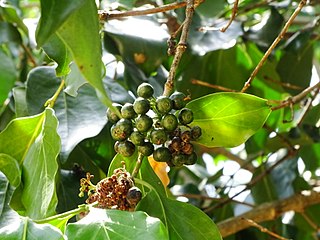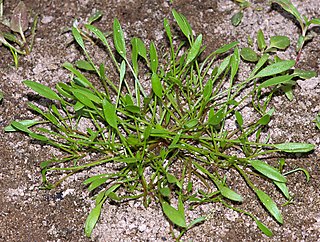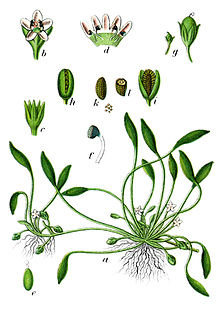
Gentiana acaulis, the stemless gentian, or trumpet gentian, is a species of flowering plant in the family Gentianaceae, native to central and southern Europe, from Spain east to the Balkans, growing especially in mountainous regions, such as the Alps and Pyrenees, at heights of 800–3,000 m (2,625–9,843 ft).

The regent bowerbird is a medium-sized, up to 25 cm long, sexually dimorphic bowerbird. The male bird is black with a golden orange-yellow crown, mantle and black-tipped wing feathers. It has yellow bill, black feet and yellow iris. The female is a brown bird with whitish or fawn markings, grey bill, black feet and crown. The name commemorates a prince regent of the United Kingdom.
The bluehead shiner is a species of fish in the carp family, Cyprinidae. It is a true minnow. It is endemic to the central United States, where it is found in Arkansas, Louisiana, Texas, and Oklahoma. It was also once known from Illinois.

Picea glehnii, the Sakhalin spruce or Glehn's spruce, is a species of conifer in the family Pinaceae. It was named after a Russian botanist, taxonomist, Sakhalin and Amur river regions explorer, geographer and hydrographer Peter von Glehn (1835—1876), the person who was the first to describe this conifer. In Japan people call this tree アカエゾマツ, which means “red spruce”.
Acrolophitus pulchellus is a species of grasshopper in the family Acrididae. It is endemic to Idaho in the United States. Its common name is Idaho point-headed grasshopper.

Psydrax dicoccos is a species of flowering plant in the family Rubiaceae. It is found from southeast China to tropical Asia.

Limosella is a genus of flowering plants known as mudworts. These are annual, largely aquatic plants, found in muddy areas worldwide. Its phylogeny and biogeography are inferred from molecular data

Arctostaphylos glauca is a species of manzanita known by the common name bigberry manzanita. It is native to California and Baja California, where it grows in the chaparral and woodland of coastal and inland hills.

Alisma lanceolatum is a species of aquatic plant in the water plantain family known by the common names lanceleaf water plantain and narrow-leaved water plantain. It is widespread across Europe, North Africa and temperate Asia. It is naturalized in Australia, New Zealand, Oregon, California and British Columbia. It is considered a noxious weed in some places.

Arctostaphylos imbricata is a species of manzanita known by the common name San Bruno Mountain manzanita.

Arctostaphylos pungens, with the common name pointleaf manzanita, is a species of manzanita. It is native to the Southwestern United States and to northern and central Mexico, where it grows in chaparral and woodland habitats, and on desert ridges. Arctostaphylos pungens can be seen growing at Tent Rocks National Monument in New Mexico at an elevation of about 6000 feet.
Hesperevax acaulis is a species of flowering plant in the aster family known by the common name stemless dwarf cudweed. It is native to California and Oregon where it grows in many types of mountain, valley, and coastal habitats, including areas recently affected by wildfire. This petite woolly annual forms a small bunch on the ground. Despite its common name it sometimes has a stem a few centimeters long. The wool-coated leaves appear in pairs or clusters, each leaf measuring a few millimeters to three centimeters long. In the center of the leaf array is the inflorescence, which is a single flower head or tightly packed cluster of several heads, each just a few millimeters wide. The flower head contains several tiny disc florets.

Limosella aquatica is a widespread species of flowering plant in the figwort family known by the common name water mudwort. It is native to much of the temperate world, where it grows in many types of wet habitat. It is semiaquatic, growing in moist land habitat such as meadows, in mud and wet sand next to water, and partly submersed or floating in the water. It is a fleshy annual herb forming low tufts in muddy substrate. The leaf is made up of a petiole up to 30 centimeters long but usually quite a bit shorter, tipped with a flat spoon-shaped blade up to 3 centimeters long. The inflorescence is an erect stalk bearing one tiny white to pink- or blue-tinted flower about 2 millimeters wide. The fruit is a capsule up to 5 millimeters wide containing many tiny seeds.

Eriocaulon parkeri is a species of flowering plant in the pipewort family known by the common names Parker's pipewort and estuary pipewort. It is native to eastern North America, where its distribution spans the coast from Quebec to North Carolina. It is extirpated from New York and Pennsylvania, however.

Tetraneuris acaulis is a North American species of flowering plants in the sunflower family. Common names include angelita daisy, stemless four-nerve daisy, stemless hymenoxys, butte marigold, and stemless rubberweed.

Aeschynomene indica is a species of flowering plant in the legume family. Common names include Indian jointvetch, kat sola, budda pea, curly indigo, hard sola, northern jointvetch, indische Schampflanze (German), angiquinho, maricazinho, papquinha, pinheirinho, he meng (Chinese), kusanemu (Japanese), diya siyambala (Sinhala), and ikin sihk (Pohnpeian).

Isoetes riparia, the shore quillwort, is a species of plant in the family Isoetaceae. It can be found in rivers, creeks, and tidal mud flats in southern Quebec and southeastern Ontario, south to eastern New York. It has 5 to 35 long, erect bright green to yellow-green leaves, which are 6 to 35 centimeters long. The velum covers one fourth of the sporangium, which can be 7 millimeters long and 4 millimeters wide. The elongated ligule can grow to be 3 millimeters long. The spherical megaspores are 430 to 680 micrometers in diameter with closely set ridges. The kidney-shaped microspores are 24-35 micrometers long, and usually have spine-tipped tubercules. The megaspores can sometimes come to resemble that of either I. echinospora, if the megaspores become eroded and bear projections that could resemble spines, or I. macrospora, if the broken ridges take a certain shape.

Isoetes tuckermanii, or Tuckerman's quillwort, is a tetraploid species of plant in the family Isoetaceae. It can be found in shallow water in Newfoundland, Nova Scotia, New Brunswick, and south through the New England states to Maryland. It bears 10 to 45 long bright green to yellow green leaves that are 4 to 25 centimeters long, usually erect, but sometimes recurved. The velum covers one fourth or less of the sporangium, which is usually unspotted, 5 millimeters long, and 3 millimeters wide. The white spherical megaspores are 400 to 650 micrometers in diameter, and bear rough-crested ridges that form a hexagonal honeycomb shape. The kidney shaped microspores are 24 to 33 micrometers long, bearing tubercles. It is very similar to I. macrospora, only reliably distinguishable by cytology or through careful megaspore measurement.

Limosella australis, common name Welsh mudwort, is an annual dicot plant that is indigenous to the United States and Canada. It has white flowers, and blooms between July to October. Its habitat is tidal mudflats, muddy or sandy shores It is listed as a special concern species in Connecticut.
















